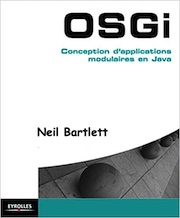
|
FreeComputerBooks.com
Links to Free Computer, Mathematics, Technical Books all over the World
|
|
- Title: Dynamic Proxies in Java
- Author(s) Heinz M. Kabutz
- Publisher: InfoQ (2020)
- Paperback: N/A
- eBook: PDF (156 pages) and ePub
- Language: English
- ISBN-10: N/A
- ISBN-13: 978-1-67804-130-4
- Share This:

|
Java is still quite easy to learn, especially if we focus on the most essential tools. Start with the syntax, then object-orientation, flow control, collections and Java 8 streams. Design patterns hold everything together.
To become a true Java Specialist, we need to also master the underpinnings of this great platform. How else can we develop systems that take advantage of the power of Java?
Dynamic proxies are such a tool. We can save thousands of lines of repetitive code with a single class. By taking a thorough look at how they work, we will recognize good use cases for them in our systems.
Dynamic proxies are not an everyday tool. They may come in handy only half a dozen times in our careers. But when they fit, they save us an incredible amount of effort. I once managed to replace over half a million code statements with a single dynamic proxy. Powerful stuff.
This book is for intermediate to advanced Java programmers who want to get to "guru" status. It is not suitable for beginners in Java.
About the Authors- Heinz M. Kabutz is the author of The Java Specialists' Newsletter, in which he explores all sorts of interesting nooks and crannies of the Java ecosystem. He is a Java Champion and a frequent speaker at all the best Java conferences, and some of the worst.
- Advanced Java Programming
- Java Enterprise Applications
- Web Services (SOAP, RESTful, etc.)
- Java Web Frameworks - Srtuts, JSF, Spring MVC, etc
 Similar Books:
Similar Books:
-
 The Java Web Scraping Handbook (Kevin Sahin)
The Java Web Scraping Handbook (Kevin Sahin)
This book will teach you how to extract data from any website, how to deal with AJAX / Javascript heavy websites, break captchas, deploy your scrapers in the cloud and many other advanced techniques, using Java programming language.
-
 Naked Objects (Richard Pawson, et al)
Naked Objects (Richard Pawson, et al)
The aim of this book is to introduce you to the concept of designing business systems from naked objects, and to enable you to start building such systems using the Naked Objects framework. It outlines a lightweight methodology and provides a short tutorial.
-
 Java Transaction Design Strategies (Mark Richards)
Java Transaction Design Strategies (Mark Richards)
This book is about how to design an effective transaction management strategy using the transaction models provided by Java-based frameworks such as EJB and Spring. Techniques, best practices, and pitfalls with each transaction model will be described.
-
 Object-Oriented vs. Functional Programming (R. Warburton)
Object-Oriented vs. Functional Programming (R. Warburton)
This book discusses similarities between these programming paradigms and points out that both FP and OOP are actually moving closer toward one another. One prominent example is the use of lambda expressions in Java and other OOP languages.
-
 High-Performance Java Platform Computing
High-Performance Java Platform Computing
Threading and concurrency are crucial to building high-performance Java applications. This book thoroughly demystifies them, helping developers leverage threading and concurrency to solve a wide variety of performance problems.
-
 Docker for Java Developers (Arun Gupta)
Docker for Java Developers (Arun Gupta)
This book introduces basic Docker concepts and explains how to achieve faster startup and deployment of your Java‑based applications, shows how Docker containers can save you many headaches when it comes to packaging, deploying, and scaling your applications.
-
 OSGi In Practice (Neil Bartlett)
OSGi In Practice (Neil Bartlett)
This book is a comprehensive guide to OSGi with two primary goals: first introducing to OSGi concepts with examples, then exploresing numerous practical scenarios and techniques, as well as answering questions.
-
 Playing with Java Microservices on Kubernetes and OpenShift
Playing with Java Microservices on Kubernetes and OpenShift
This book is written for Java developers who wants to build microservices using the Spring Boot/Cloud stack and who wants to deploy them to Kubernetes and OpenShift. Heach you how to build and design microservices using Java and the Spring platform.
-
 Microservices for Java Developers: Frameworks and Containers
Microservices for Java Developers: Frameworks and Containers
In this hands-on, example-driven guide, Java developers and architects will learn how to navigate popular application frameworks, such as Dropwizard and Spring Boot, and how to deploy and manage microservices at scale with Linux containers.
-
 Microservices Best Practices for Java (Michael Hofmann, et al)
Microservices Best Practices for Java (Michael Hofmann, et al)
This book covers Microservices best practices for Java. It focuses on creating cloud native applications using the latest version of Server and other Open Source Frameworks in the Microservices ecosystem to highlight Microservices best practices for Java.
-
 Developing Reactive Microservices: Implementation in Java
Developing Reactive Microservices: Implementation in Java
In this book, author walks Java developers through the creation of a complete reactive microservices-based system. The result? A system that's easier to deploy, manage, and scale than a typical Java EE-based infrastructure.
-
 RESTful Java with JAX-RS 2.0: Designing and Developing
RESTful Java with JAX-RS 2.0: Designing and Developing
With the book's technical guide, you'll learn how REST and JAX-RS work and when to use them. It provides step-by-step instructions for installing, configuring, and running several working JAX-RS examples, using the JBoss RESTEasy implementation.
-
 Real-World Maintainable Java Software (Abraham Marin-Perez)
Real-World Maintainable Java Software (Abraham Marin-Perez)
With this practical book, you'll learn 10 easy-to-follow guidelines for delivering Java software that’s easy to maintain and adapt. These guidelines have been derived from analyzing hundreds of real-world systems.





